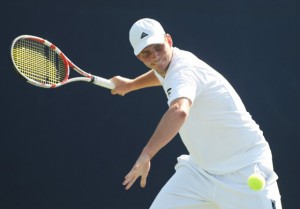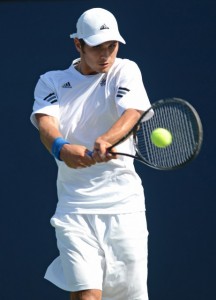From cherry picking in Yakima, Wash., to photo ops with rocky hills along a scenic drive to Portland, Ore., Robin Anderson’s experience with her United States Tennis Association collegiate squad provided a lighthearted change of pace for the Bruin.
Traveling to a flight back home after a tournament in Yakima, the rising junior enjoyed the simpler parts of life during a summer with few breaks.
“Usually on road trips, I never really paid attention to what was around me, and now being on the team, this is a new experience for all of us, and we’re enjoying all the little things, like the scenery,” Anderson said.

Twelve women and 12 men are invited by the USTA to participate in a four-day training camp, although only players achieving certain rankings or winning specific singles tournaments are guaranteed one of six final roster spots on each team.
On top of receiving free coaching, athletes on the final roster are covered for hotels when playing in USTA Pro Circuit events, such as the Yakima competition, and receive grant money for food, flights and racket maintenance. Collegiate team benefits run through the end of the 2013-2014 NCAA season.

McPhillips’ bid to make the team ended after a round-robin competition held during training camp last month, while Giron’s status will be decided by his performance in summer tournaments. Because his playoff competition was rained out, making the team will require Giron to outperform a majority of his peers in USTA events.
Giron will earn points based on how far he gets in tournaments that are weighted differently based on level of competition. Giron could make the roster on Aug. 12 if he accumulates at least the third-most points among seven other invitees. Both McPhillips and Giron received $2,000 grants to cover tennis expenses for the rest of this summer.
In February, the program shifted from a seasonal format to become a year-round resource to accommodate players wanting to enter USTA Pro Circuit events during the academic year. Athletes can receive additional training and coaching that they would not be able to get from school coaches, since the NCAA limits the set amount of time players can practice under their college coaches, said Dustin Taylor, USTA national collegiate coach.
Taylor believes that participation in the elite training camps, each of which are run by two USTA-selected collegiate coaches, pushes players to the best of their abilities. He also said that road-tripping with peers via van to professional tournaments is an indispensable experience for collegiate players seeking a living in the sport.
“(Professional players) will be on tour, they’ll want to have those friendships and relationships with their countrymen. I don’t want to say it’s lonely, but week in and week out, it’s … a new city, a new country, a lot of the times,” Taylor said.
“It’s good to make those connections with, sometimes, your biggest rivals … so when you leave college, there’s a good chance you’re sticking together.”
Anderson appreciated the experience, describing her June training camp as “probably the best USTA camp” she has ever attended. Anderson feels a team environment, such as the one the USTA collegiate squad fosters, provides a support system that helps get her through matches.
“I sometimes see players (on their own during tournaments) and they look so miserable. You have these coaches and players here supporting you, practicing with you every day, helping you out during the match, and whether you win or not, they’re still here for you.”
Taylor noticed how Anderson relished the team setting and identified a sense of belonging to something greater than the individual as one of the most vital aspects of college players’ development.
“I don’t think you go a minute or two without her smiling, and her smile really lights up the room. … She brings a happy-go-lucky, bubbly personality that all the girls and coaches have grabbed onto,” Taylor said. The USTA coach added that he felt a team dynamic among his women’s team unlike any he has seen with previous squads.
Giron cited his experience in junior tennis as an explanation for why his familiar teammates were “really friendly and supportive of each other.” Despite occasional friendly banter about past matches, Novikov felt that the men’s camp retained the feel of “a working environment” conducive to athletes pushing each other to improve.
The coaches’ emphasis on drilling and individual techniques provided Giron a welcome change from playing match points during NCAA-season practices. Giron said that his training experience, which he recognizes won’t translate to improvements overnight, helped him think more carefully about decision-making on the court.
“The biggest thing I took out of training is really understanding when to attack the ball and when to defend the ball depending on how the opponent hits the ball,” he said.
The small picture captured by the skills refined and memories created during the collegiate team’s summer camps and tournaments helps to develop what Taylor sees as bright professional futures for Anderson, Novikov, Giron and McPhillips.
“They’ve come a long way since I’ve seen them as (junior tennis players), and that’s a testament to UCLA. If they want to play professional tennis … they’ve got the attributes to do it, but it’s got to come from them, and it’s got to be something they want to do,” Taylor said.
